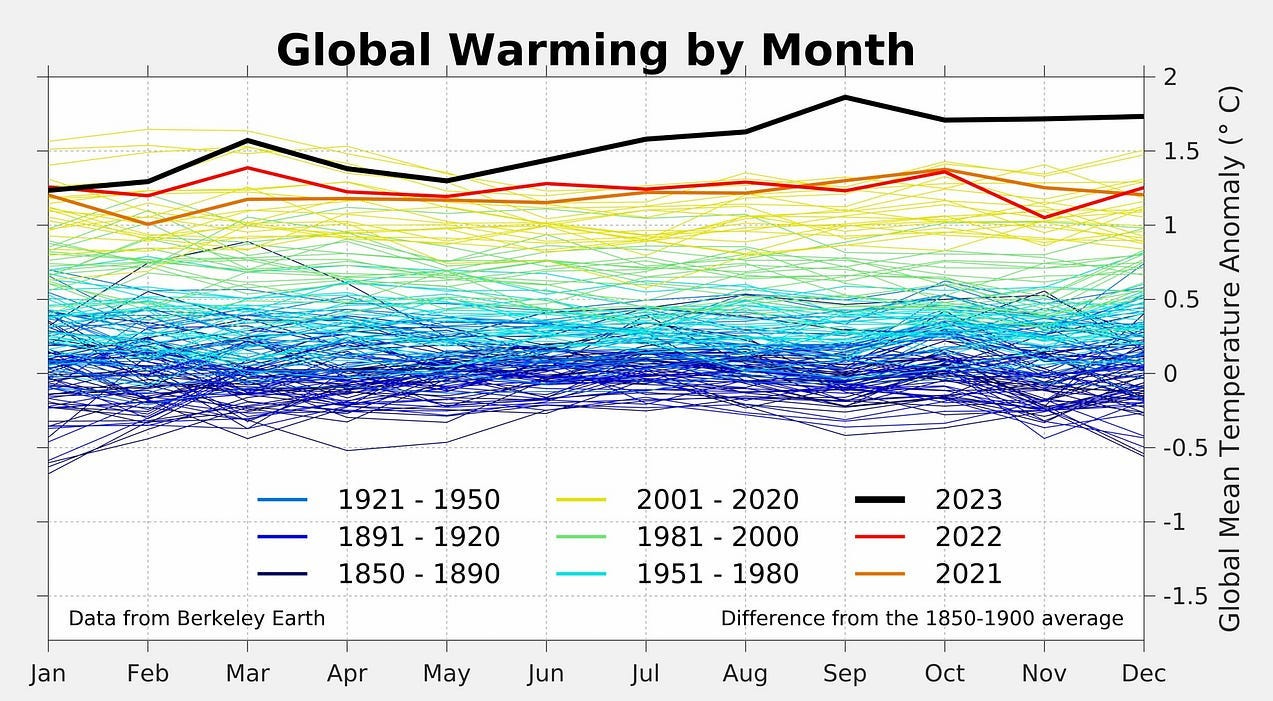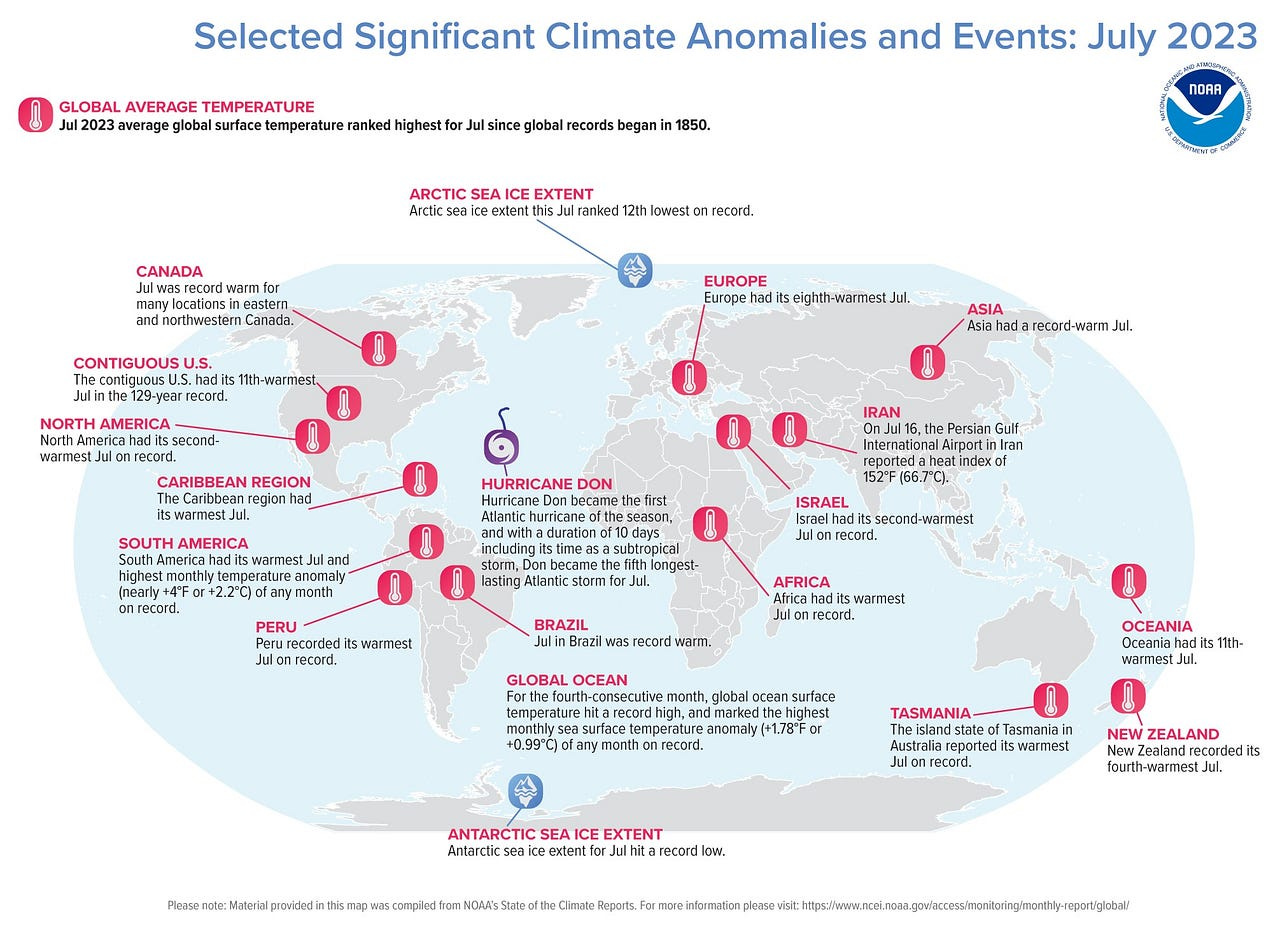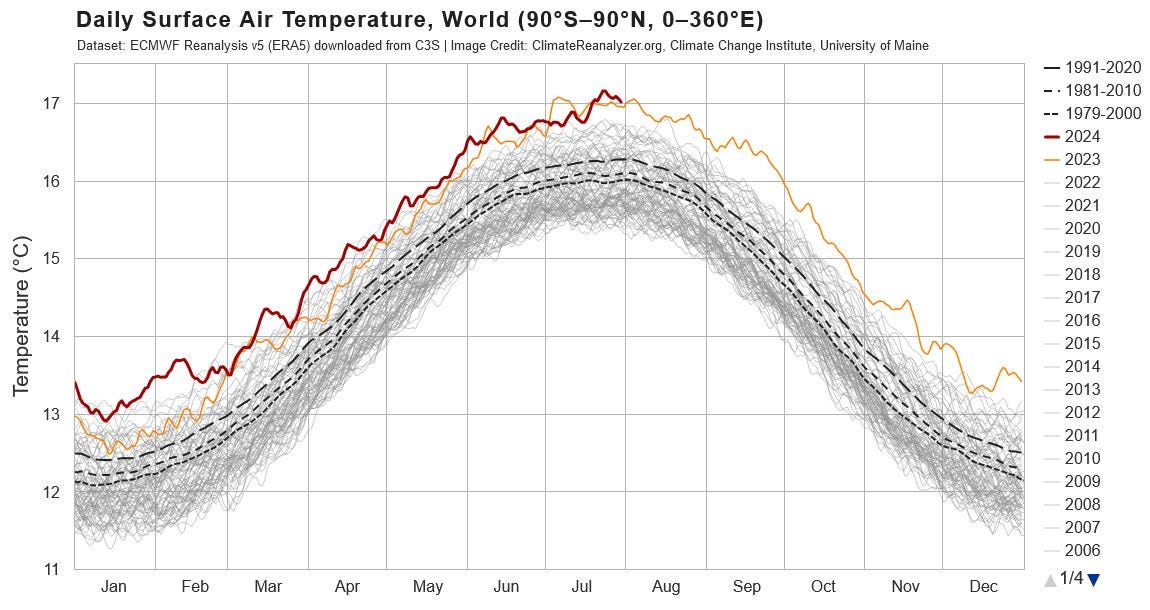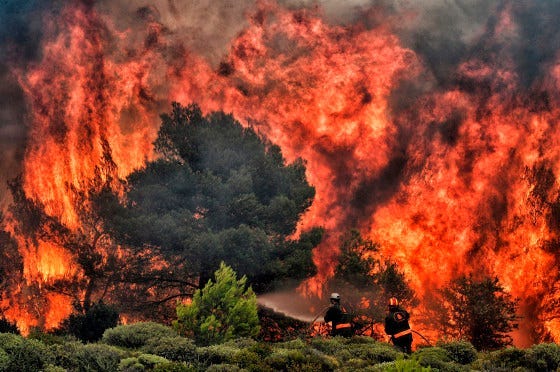In more ways than you might expect.

Surface Air Temperature is the metric most people think of when they think of “Global Warming”. As you can see, global temperatures increased dramatically in 2023.
From about +1.2°C over the GISS baseline in January to about +1.7°C over baseline by December.
Now, when the mainstream press reports the 2023 temperature as being +1.56°C over baseline. That’s the GISS average for the year.
The year started low, then ended high. +1.56°C is somewhere in the middle and in a “normal” year that average would be a reasonable way to discuss the global temperature for 2023.
Look at the graph. 2023 wasn’t NORMAL. Temperatures dropped from a peak of around +1.9°C (the EU say +2.1°C) to about +1.7°C over baseline at the end of September 2023. Then they STAYED THERE.
That’s what happens during an El Nino. The earth warms up the “first year” and that heat carries into the winter of the “second year”. That heat warms the Northern Hemisphere and bleeds off into the heat sinks of the High Latitudes.
As the temperature of the oceans fall, the global temperature falls, and the planet cools down from the heat release of the El Nino. That’s how the system is supposed to work.
Things have NOT cooled down in 2024

No matter how you look at it.
We just had a full year where EVERY DAY was warmer than the +1.5°C it was in June 2023.
June 2024: Earth’s 13th-consecutive warmest month on record.
June 2024 was Earth’s warmest June since global record-keeping began in 1850 and was the planet’s 13th consecutive warmest month on record, NOAA’s National Centers for Environmental Information, or NCEI, reported July 12.
As opposed to being focused in one region or another, the record heat was unusually widespread, with 14.5% of the world’s surface experiencing record heat — beating the previous June record set in 2023 by 7.4%.

THINGS HAVE NOT COOLED DOWN IN 2024.
That has implications about the future. Implications about “how fast” things will get worse.
Because, in 2023 the level of atmospheric CO2 jumped 84% more than usual.
World’s forests failed to curb 2023 climate emissions, study finds. — Reuters 072924
SAO PAULO, July 29 (Reuters) — Forests and other land ecosystems failed to curb climate change in 2023 as intense drought in the Amazon rainforest and record wildfires in Canada hampered their natural ability to absorb carbon dioxide, according to a study presented on Monday.
That means a record amount of carbon dioxide entered Earth’s atmosphere last year, further feeding global warming, the researchers said.
How much more?
The growth rate of carbon dioxide in the atmosphere jumped 86% in 2023 compared to 2022. The CO2 level increased by +3.51ppm in a SINGLE year.
One of Earth’s major carbon sinks collapsed in 2023. — Schib.com 072524
“Extreme heat, drought and wildfires caused forests and other land ecosystems to emit almost as much carbon dioxide as they removed from the atmosphere in 2023, nearly canceling out a major natural sink of the greenhouse gas.”
Researchers say the TEMPORARY (emphasis mine) decline of this sink — which usually removes about a quarter of our annual CO2 emissions from the atmosphere — bodes ill for how these ecosystems will respond to future climate change.
Here’s the paper these articles are referencing.
Low latency carbon budget analysis reveals a large decline of the land carbon sink in 2023 — This study was presented at the International Carbon Dioxide Conference in Manaus, Brazil, July 2024
Now, to understand this paper you need some context.
From the articles:
Philippe Ciais at the Pierre-Simon Laplace Institute in France and his colleagues set out to explain why 2023 saw a jump in atmospheric CO2 that was far greater than could be explained by an increase in human-caused emissions alone. The researchers analyzed measurements of atmospheric CO2 and used models of the global carbon cycle to understand what was behind this rapid rise.
They found that changes in the balance between the amount of CO2 taken up and emitted by ecosystems on land was the main culprit.
Here’s what’s being discussed.
Human Emissions are projected to have risen 1.1 percent in 2023 to have reached a record high of +37.55 GtCO₂
FYI- A single gigatonne is 1,000,000,000 tonnes, and is often used when discussing human carbon dioxide emissions. This is roughly the mass of all land mammals (other than humans) in the world. It’s also roughly twice the mass of all of the people in the world.
NORMALLY, the Terrestrial Land “Sinks” absorb about 25% of that CO2 each year. That’s about 9.35 GtCO2 annually.
This “land carbon sink” exists because forests and other land ecosystems take up slightly more CO2 as they grow than they release when plants die and decompose or burn each year.
Despite the claims of Deniers that increased levels of CO2 will spur plant growth and “balance our emissions”. Studies have found that the “CO2” boost has been about 2 GtCO2/year over the last decade. The effect is real, but not nearly enough to “balance human emissions”.
In 2023, the Terrestrial Land Sinks only absorbed about 0.44 GtCO2.
In 2023, however, the land sink removed only about 0.44 GtCO2 — the lowest amount since 2003 and more than three times lower than the average over the past decade, according to the researcher’s estimates.
Conversely, they found that the ocean carbon sink increased in 2023 by around a gigatonne, ruling the oceans out as a source of the jump in atmospheric CO2.”
So, about an extra 8 GtCO2 went into the atmosphere last year.
That extra 8GtCO2 is why the CO2 count in Mauna Loa jumped so much last year. It’s what pushed us up past +3ppm in a single year.
If this keeps up. Well, it’s obvious how much faster things will get a LOT WORSE.
So, with that in mind. Why do these researchers think this happened and do they think it will become the “new normal”?

Abstract:
In 2023, the CO2 growth rate was 3.37 ± 0.11 ppm at Mauna Loa, 86% above the previous year, and hitting a record high since observations began in 1958[1], while global fossil fuel CO2 emissions only increased by 0.6 ± 0.5%[2,3].
This implies an unprecedented weakening of land and ocean sinks, and raises the question of where and why this reduction happened.
Here we show a global net land CO2 sink of 0.44 ± 0.21 GtC yr-1, the weakest since 2003. We used dynamic global vegetation models, satellites fire emissions, an atmospheric inversion based on OCO-2 measurements, and emulators of ocean biogeochemical and data driven models to deliver a fast-track carbon budget in 2023. Those models ensured consistency with previous carbon budgets[2].
Regional flux anomalies from 2015–2022 are consistent between top-down
and bottom-up approaches, with the largest abnormal carbon loss in the Amazon during the drought in the second half of 2023 (0.31 ± 0.19 GtC yr-1), extreme fire emissions of 0.58 ± 0.10 GtC yr-1 in Canada and a loss in South-East Asia (0.13± 0.12 GtC yr-1). Since 2015, land CO2 uptake north of 20°N declined by half to 1.13 ± 0.24 GtC yr-1 in 2023. Meanwhile, the tropics
recovered from the 2015–16 El Niño carbon loss, gained carbon during the La Niña years (2020–2023), then switched to a carbon loss during the 2023 El Niño (0.56 ± 0.23 GtC yr-1).
The ocean sink was stronger than normal in the equatorial eastern Pacific due to reduced upwelling from La Niña’s retreat in early 2023 and the development of El Niño later[4].
Land regions exposed to extreme heat in 2023 contributed a gross carbon loss of 1.73 GtC yr-1, indicating that record warming in 2023 had a strong negative impact on the capacity of terrestrial ecosystems to mitigate climate change.
End.
— — — — — — — —
The first line of the ABSTRACT states:
“In 2023, the CO2 growth rate was 3.37 +/- 0.11 ppm at Mauna Loa, 86% above the previous year, and hitting a record high since observations began in 1958, while global fossil fuel CO2 emissions only increased by 0.6 +/- 0.5%.”
SO.
In 1958 the Rate of CO2 Increase (RoCI) was about = +0.6ppm/year.
In 2023 the Rate of CO2 Increase (RoCI) was about = +3.37ppm/year.
The RATE that CO2 is building up in the atmosphere each year has increased about 700% since 1958. At a rate of +3.3ppm/year annual increase we add +100ppm of CO2 to the atmosphere in just 30 years.
An increase of +3ppm/year of atmospheric CO2 puts us at 520ppm levels by 2050. In the paleoclimate data that indicates global temperatures of +5°C to +6°C of warming over the 1850 baseline.
If CO2 levels continue to increase at this rate then we are looking at a complete collapse of global agriculture by 2050. Food production “to scale” will be possible only in sheltered micro-climate refugium or in climate controlled greenhouses.
At 520ppm levels of CO2 our civilization is OVER.
You would think that this news would have gotten more coverage in the press.
Other than the articles I listed, I haven’t seen any others.
WHY?
Two words, “natural variation”.
The “catch-all” phrase that soothes “climate anxiety” and gets papers and articles like this ignored by the mainstream press. The authors of the paper themselves emphasize that the “carbon uptake” of the terrestrial sinks is variable from year to year.
They also discuss that a similar crash in the terrestrial land sinks happened in 2003. This is not “unprecedented”.
When you combine those two facts it becomes easy to dismiss this study as “natural variation”. To say, “2023 was a BAD year, but things will go back to normal”. After all, it wasn’t any worse than 2003.
At this point it’s still easy to take a “wait and see” attitude about this if you are inclined towards “minimizing” the magnitude of the unfolding Climate Crisis. But the bottom line is this.
The failure of the Terrestrial Land Sinks in 2023 added about 8 GtCO2 to the atmosphere. This resulted in the atmospheric CO2 level increasing about +3.3ppm in 2023 instead of the expected +2.5ppm.
That 8 GtCO2 was about +0.8ppm of EXTRA CO2 added to the atmosphere in 2023. If this continues we have to immediately reduce our CO2 output by -9 GtCO2 just to “break even” so that things won’t get worse.
THIS IS A “TIPPING POINT” MOMENT.
If the terrestrial carbon sinks stop “eating carbon”, even if they don’t add any carbon to the atmosphere, things will RAPIDLY get worse. If this starts happening more often global warming will accelerate and our civilization could completely crash by 2050.
So, what happened in 2023?
Short version:
The Amazon and SE Asia dried out.
“Imagine your plants at home: If you don’t water them, they’re not very productive, they don’t grow, they don’t take up carbon. Put that on a big scale like the Amazon forest,” — Stephen Sitch, a study co-author and carbon expert at the University of Exeter
This prevented them from taking up more carbon.
And, Canada BURNED.
That’s all it takes to “shut down” the Terrestrial Carbon Sinks it turns out. A LOT less than you might have imagined.
The paper cautions that Earth’s carbon sink varies widely year to year, and a single year alone does not spell doom. But it would be alarming if what was observed in 2023 becomes a trend.
“This is a warning,” said Richard Birdsey of Woodwell Climate Research Center in the United States, who was not involved in the study. “There’s a good chance that years like 2023 are going to be more common.”
Ummm….like this year?
2024 has been AT LEAST as HOT as 2023.
It’s looking like our new baseline temperature.
Remember the 13 consecutive months of new global heat records.
Conditions have NOT gotten better.
In California:
The Park fire became the fifth-largest in state history after it grew to 12 times the size of San Francisco. Hot and dry weather had turned the forest into a tinderbox. It could now burn for weeks, if not months, and has the potential to become the largest fire in California’s history.
In Canada and Siberia:
Smoke over the Arctic Circle as boreal wildfires intensify in Siberia and North America.

The Copernicus Atmosphere Monitoring Service reported this month that fires in Canada were above average in some regions, and about 25,000 people had to be evacuated from their homes when Jasper National Park in Alberta was burned by the biggest blazes it’s experienced in a century.
And Russia reported a 50 percent increase in area burned compared to last year, as immense blazes sent smoke above the Arctic Circle.
In the Amazon:
Rains Are Scarce in the Amazon. Instead, Megafires Are Raging. — NYT 03/24
In Brazil, the Amazon hasn’t seen this many fires in the first six months of the year in almost two decades.
Hundreds of square miles of the rainforest have burned as countries in the region battle a record number of fires fueled by extreme weather. In the beginning of the year, a time when the rainy season usually has started, the northern tip of the Amazon experienced a record number of wildfires.
And now, the Pantanal, the world’s largest tropical wetland, between Brazil and Bolivia, is also experiencing a record number of fires.
In the US:
Fires are happening in places that should be too wet to support them. Louisiana, one of the wettest places in the United States, was on fire last year.
Here’s what the researchers found that happened in 2023.
“During the first half of the year, the researchers attributed the change in the land carbon sink to slower vegetation growth in ecosystems in the northern hemisphere, along with extreme wildfires in Canada, other parts of the Arctic, and South-East Asia.”
“Drought and fires weakening the Amazon carbon sink in the second half of the year made up the largest portion of the change, offsetting increased take-up in places like central Africa that saw wetter conditions.”
“Driving these changes were 2023’s record high temperatures, which were mainly due to rising greenhouse gases and a shift to hotter El Niño conditions in the middle of the year.”
The team found that almost 30 per cent of the decline in the land carbon sink was due to net emissions in areas that saw the hottest 5 per cent of temperatures, as the heat stressed ecosystems and exacerbated drought and fire.
“The decline of the northern [land] sink was masked by recent good conditions in the Tropics absorbing CO2, but in the coming years if this decline continues, we may see a rapid acceleration of CO2 and global warming which was unforeseen in future climate models projections.”
“Whether 2023’s weakened land carbon sink represents a passing response to an extremely hot year or a more lasting shift remains uncertain.” — Author’s
Here are several comments on the paper.
“The less carbon the land ecosystems absorb, the less fossil fuels the world can burn before humankind blows past global climate targets”
— Anthony Walker, an ecosystem modeler at the Oak Ridge National Laboratory in the United States who was not involved in the study.
“We cannot count on ecosystems to bail us out in the future,”
— Trevor Keenan, an ecosystem scientist at University of California, Berkeley who was not involved in the study.
2024 has been AT LEAST as HOT as 2023.
The Future is Now.
This is my analysis.
This is what I see.
This is my “Crisis Report”.
rc 080424
Notes:
What about 2003?
Well, it was HOT.
The year began with El Niño conditions, which meant that sea surface temperatures over the equator over the eastern Pacific Ocean were anomalously warm.
There were a LOT of wildfires.
In January, high winds and lightning ignited bushfires in Canberra, Australia’s capital city, which burned 70% of the territory’s nature areas before being contained. The fires killed four people and caused 435 injuries. Throughout the northern hemisphere summer, wildfires burned 10% of Portugal’s territory, killing 19 people.
Europe ROASTED.
The 2003 European heat wave saw the hottest summer recorded in Europe since at least 1540. France was hit especially hard. The heat wave led to health crises in several countries and combined with drought to create a crop shortfall in parts of Southern Europe. The death toll has been estimated at more than 70,000.
All of this supports the thesis of this paper.
The terrestrial carbon sinks seem to be more sensitive to environmental conditions than previously expected. A HOT YEAR that severely impacts about 5% of the land surface can shut down about 30% of the sink.
2003 shows that it’s about temperatures and that crashes like this probably aren’t “natural variation”.
— — — — — -
I harp on this I know, but our world is going to BURN over the next 20–30 years.
Extreme Wildfires Have Doubled in 2 Decades, Study Finds — NYT 06/24
In a changing climate, extreme wildfire events are becoming far more common and more intense, according to a new analysis.
Increasing frequency and intensity of the most extreme wildfires on Earth. —Nature Ecology & Evolution (2024)
Abstract:
Climate change is exacerbating wildfire conditions, but evidence is lacking for global trends in extreme fire activity itself. Here we identify energetically extreme wildfire events by calculating daily clusters of summed fire radiative power using 21 years of satellite data, revealing that the frequency of extreme events (≥99.99th percentile) increased by 2.2-fold from 2003 to 2023, with the last 7 years including the 6 most extreme. Although the total area burned on Earth may be declining, our study highlights that fire behaviour is worsening in several regions — particularly the boreal and temperate conifer biomes — with substantial implications for carbon storage and human exposure to wildfire disasters.
Takeaways:
Both the frequency and intensity of extreme wildfires have more than doubled in the last two decades.
Most of these more powerful fires happened in the temperate conifer forests of the United States and Canada.
In these forests extreme fire events increased by more than 11-fold, from six in 2003 to 67 in 2023.
Overall, in the boreal forests that stretch across North America and Asia, there was a 7.3-fold increase in extreme wildfires
Michael Falkowski, who manages the Wildlands Fires program at NASA, explained that hotter temperatures make the atmosphere “thirsty” so “it sucks more moisture out of the soil and vegetation.” Drier forests are more flammable and fuel bigger wildfires.
Given these facts, it seems clear that the Land Carbon Sinks are going to degrade “faster than expected”. Without MASSIVE investment in rapid decarbonization and sustainable energy sources we are going to “get pinched” between our increasing CO2 pollution and the collapse of the natural carbon sinks.
— — — — —
Related to that, I saw this article.
Dozens of bridges across the U.S. will get upgrades, thanks to a $5 billion grant from the Federal Highway Administration. The recipients of the grant were announced Wednesday, though they make up a fraction of the nation’s bridges in need of repair:
$1.4 billion — Amount the Pacific Northwest’s Interstate 5 bridge will receive, the most of any grant.
42 — The number of bridges that that will be repaired and reconstructed.
‘The biggest investment in our bridges since the Eisenhower era”
U.S. Transportation Secretary Pete Buttigieg
600,000 — Number bridges in the United States as of 2019.
54,000 — The number that are in critical need of repair.
This grant fixes 42 out of 54,000.








But burning forrests are feature not a bug. Look on the bright side. If we can get every major woodland carbon sink to burn down then Co2 doesn't matter. We will have enough smoke and other sunlight blocking debrie to increase albedo to volcano like levels. Thus we cool right off. And after that some majic technology will take over and all the trees will grow back. And the rivers will flow champaign because we will be in Heaven cause we are all dead. I like to think of it this way . . . .
Another excellent--and sobering--article.